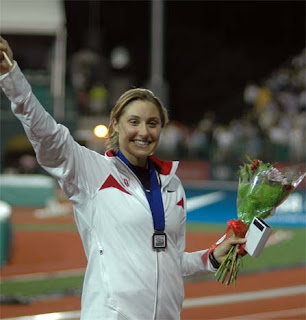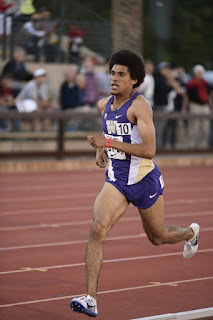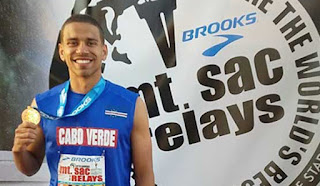Links of the day--an update from Kara Patterson, plus the lack of dual meets...
Today's links of the day include a blog entry from Vancouver's Kara Patterson (left/photo by Paul Merca), who writes about setting a practice PR in a training session.
Patterson, who set the American record in the javelin last season, writes, "I set a training goal last year to throw 60 meters in practice. I never achieved that, but I raised it this year because of the success that I saw in competition during 2010. So, although I'm really happy about meeting last year's goal today and setting a new practice personal record :), I'm more excited about striving toward this year's aspirations."
You can read the entry here.
Incidentally, she will open her 2011 campaign at the Drake Relays in Des Moines, Iowa at the end of the month, and she also let us know that she has a new agent in Daniel Wessfeldt from Sweden's JRS Sport Management. His firm also represents former Washington State high jumper Ebba Jungmark and ex-Washington middle distance runner Ingvill Måkestad.
The other top link of the day is a preview of Saturday's Pepsi Team Invitational in Eugene, featuring the Huskies, Ducks, along with Stanford and Nebraska.
The Oregonian's Ken Goe writes that college track & field's lack of emphasis on team scoring is one of the biggest reasons why there's a decline in popularity with the general public.
Ken's right.
My first exposure to a collegiate track meet was as a ninth grader at Sharples Junior High School in Seattle, when the University of Washington gave away tickets for a dual meet at Husky Stadium against San Jose State, which by the way, used to be a track powerhouse.
On the meet program, there was a picture of San Jose State's Mark Schilling and the UW's Greg Gibson, as one of the feature races was a race between the two (can't remember whether it was over 880 or a mile).
The fact that there's only 12.6 total men's scholarships and 18 for women in Division I track & field makes it difficult to field complete teams. In fact, the trend for most schools nowadays is to bank scholarship money on certain event groups instead of fielding well rounded teams; i.e., the UW women's team, Oklahoma State, and Portland are the three schools that come immediately to mind, as they put the majority of their money on distance runners.
In their defense, those schools, and many others, get the most out of their money banking on an event group, as distance runners can cover cross country, indoor track, and outdoor track. So from an economic standpoint, I don't blame them.
As an aside, I should note that in the late 70s and early 80s, the UW put a lot of scholarship money in the throws when Ken Shannon was the head coach.
But that's not a track team.
Oregon coach Vin Lananna points out in Goe's article, “I’ll be quick to follow up and say as long as we have a ludicrous number of scholarships, 12.6 for men and 18 for women, it makes it very difficult. It’s a great idea, a great concept. But it’s really hard. There are 21 events in track and field and 12.6 grants. We don’t even have a starting lineup.”
You can read Goe's article here.
Patterson, who set the American record in the javelin last season, writes, "I set a training goal last year to throw 60 meters in practice. I never achieved that, but I raised it this year because of the success that I saw in competition during 2010. So, although I'm really happy about meeting last year's goal today and setting a new practice personal record :), I'm more excited about striving toward this year's aspirations."
You can read the entry here.
Incidentally, she will open her 2011 campaign at the Drake Relays in Des Moines, Iowa at the end of the month, and she also let us know that she has a new agent in Daniel Wessfeldt from Sweden's JRS Sport Management. His firm also represents former Washington State high jumper Ebba Jungmark and ex-Washington middle distance runner Ingvill Måkestad.
The other top link of the day is a preview of Saturday's Pepsi Team Invitational in Eugene, featuring the Huskies, Ducks, along with Stanford and Nebraska.
The Oregonian's Ken Goe writes that college track & field's lack of emphasis on team scoring is one of the biggest reasons why there's a decline in popularity with the general public.
Ken's right.
My first exposure to a collegiate track meet was as a ninth grader at Sharples Junior High School in Seattle, when the University of Washington gave away tickets for a dual meet at Husky Stadium against San Jose State, which by the way, used to be a track powerhouse.
On the meet program, there was a picture of San Jose State's Mark Schilling and the UW's Greg Gibson, as one of the feature races was a race between the two (can't remember whether it was over 880 or a mile).
The fact that there's only 12.6 total men's scholarships and 18 for women in Division I track & field makes it difficult to field complete teams. In fact, the trend for most schools nowadays is to bank scholarship money on certain event groups instead of fielding well rounded teams; i.e., the UW women's team, Oklahoma State, and Portland are the three schools that come immediately to mind, as they put the majority of their money on distance runners.
In their defense, those schools, and many others, get the most out of their money banking on an event group, as distance runners can cover cross country, indoor track, and outdoor track. So from an economic standpoint, I don't blame them.
As an aside, I should note that in the late 70s and early 80s, the UW put a lot of scholarship money in the throws when Ken Shannon was the head coach.
But that's not a track team.
Oregon coach Vin Lananna points out in Goe's article, “I’ll be quick to follow up and say as long as we have a ludicrous number of scholarships, 12.6 for men and 18 for women, it makes it very difficult. It’s a great idea, a great concept. But it’s really hard. There are 21 events in track and field and 12.6 grants. We don’t even have a starting lineup.”
You can read Goe's article here.



Comments